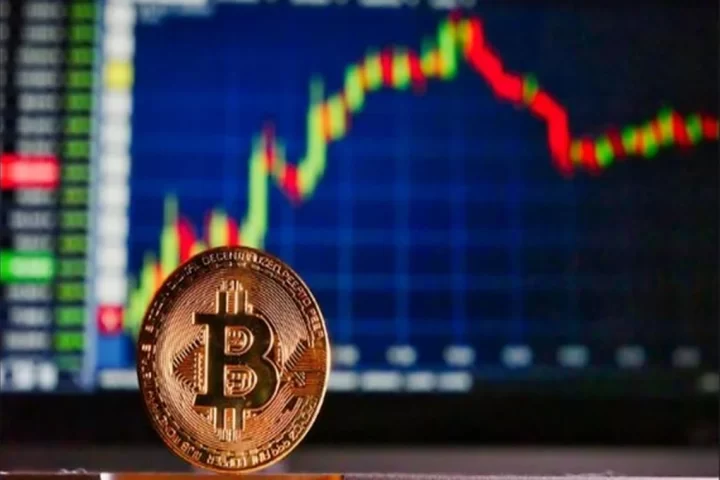Gold-tracking exchange-traded funds (ETFs) in 2024 have witnessed significant outflows, amounting to billions, in stark contrast to ETFs tracking the spot price of Bitcoin.
As per an X post from Bloomberg intelligence analyst Eric Balchunas on Feb. 14, the foremost gold ETFs have encountered outflows totaling $2.4 billion thus far in 2024.
Only three among them have experienced marginal inflows this year: VanEck Merk Gold Shares, FT Vest Gold Strategy Target Income ETF, and Proshares UltraShort Gold.
Notably, the most substantial outflows emanated from BlackRock’s iShares Gold Trust Micro and iShares Gold Trust, with $230.4 million and $423.6 million exiting, respectively.
Conversely, the ten sanctioned spot Bitcoin ETFs have garnered cumulative inflows of $3.89 billion and registered unprecedented volume since their inception on Jan. 11, according to preliminary data from Farside.
Commenting on the trend, portfolio manager Bitcoin Munger remarked, “Not only is Bitcoin sucking up funds, but gold is hemorrhaging AUM at an alarming rate across many ETFs.”
Balchunas, however, opined that the migration of gold ETF investors to Bitcoin ETFs wasn’t necessarily prevalent, suggesting it could be attributed to “US equity FOMO” instead.
Bitcoin pioneer Jameson Lopp shared a chart comparing the performance of the two ETFs, raising questions about the stance of gold investor and Bitcoin detractor Peter Schiff.
READ MORE: HectorDAO Investors Demand Control Amidst $2.7 Million Hack Scandal
The disparity has been exacerbated by the decline in gold prices throughout 2024. The precious metal has depreciated by 3.4% since the year’s commencement, reaching a two-month low of $1,993 per ounce on Feb. 14.
Meanwhile, Bitcoin prices have surged by 23.5% over the same period, hitting a two-year high of $52,483 on Feb. 14.
In a report released earlier in February, the World Gold Council highlighted global gold ETF outflows and a “reduction in speculative positioning” as significant factors contributing to gold’s subdued performance.
It also noted that “Long-term Treasuries and the US dollar, on the back of strong upside US economic surprises, were also headwinds.”
While Bloomberg senior commodity strategist Mike McGlone had previously forecasted gold outperforming Bitcoin in 2024, current observations suggest otherwise.
Bitcoin and gold, often compared for their shared store of value attributes, have historically been favoured investments during economic and geopolitical uncertainties.
Bitcoin surged to new two-year highs on February 14, delighting enthusiasts with a Valentine’s Day surprise.
Data from Cointelegraph Markets Pro and TradingView revealed a robust rebound in BTC prices from the previous day’s lows of $48,400.
During the Asian trading session, Bitcoin not only recovered from a sudden 4% decline but also soared to long-term highs, aiming for $52,000 at the time of writing.
Typical bullish behaviour saw BTC/USD gaining $1,000 within a single hourly candle, while the overall crypto market capitalisation approached the $2 trillion mark with Bitcoin’s surpassing $1 trillion.
Analysing the short-term setup, renowned trader Skew identified an ongoing reversal of resistance/support levels on the four-hour chart.
He highlighted key trendlines involving exponential moving averages (EMAs) and the relative strength index (RSI) score.
“I think so far this trend is fairly straightforward as long as the market sustains current bullish momentum,” he stated in part of his latest post on X (formerly Twitter).
“4H EMAs will provide nice & concise trend confirmations along with RSI for momentum with current trend, as well when its clear current momentum is lost.
READ MORE: Ledger and Coinbase Join Forces to Simplify Crypto Transactions and Enhance Self-Custody Options
Key closes often with these trends are daily open & weekly open.”
On Binance, Skew additionally observed that spot buyer interest had anticipated institutional inflows via the United States spot Bitcoin exchange-traded funds (ETFs).
As reported by Cointelegraph, these ETFs continue to gain traction, with nine providers acquiring more BTC daily.
Taking a broader perspective, popular trader and analyst Rekt Capital suggested that events were unfolding in accordance with the classic bull markets for Bitcoin.
The timing of the BTC price resurgence towards all-time highs was “right on schedule,” he informed X followers this week.
Drawing parallels to 2020, Rekt Capital highlighted the cathartic impact of the block subsidy halving, with BTC/USD typically commencing a “pre-halving rally” two months in advance.
The next halving is anticipated in mid-April.
Countless Bitcoin price predictions for 2024 and 2025 indicate a very bullish scenario for BTC.
Bitcoin, the first and most well-known cryptocurrency, has seen a tumultuous journey since its inception in 2009. Its price has experienced dramatic fluctuations, reflecting a range of factors including investor sentiment, regulatory news, and changes in the broader financial ecosystem. As we look towards 2024 and 2025, Bitcoin price predictions are becoming increasingly important for investors trying to navigate the volatile crypto market.
The Factors Influencing Bitcoin Price Predictions
Before diving into specific Bitcoin price predictions for 2024 and 2025, it’s crucial to understand the factors that can influence its value. These include:
- Adoption Rates: As more businesses and consumers adopt Bitcoin for transactions, its value could increase due to heightened demand.
- Regulatory Environment: Regulations can have a significant impact on Bitcoin’s price. Positive regulatory developments can lead to price increases, while stringent regulations may have the opposite effect.
- Technological Advances: Innovations, such as improvements in blockchain technology, can enhance Bitcoin’s functionality and appeal, potentially boosting its price.
- Market Sentiment: Investor sentiment, often driven by news and social media, can cause sudden and dramatic price movements.
- Macroeconomic Factors: Global economic trends, including inflation rates and currency fluctuations, can influence Bitcoin’s attractiveness as an investment.
Bitcoin Price Prediction for 2024
Looking ahead to 2024, Bitcoin price predictions are mixed, reflecting the diverse views of analysts. Some experts are bullish, citing increasing adoption of cryptocurrencies and potential technological advancements as key drivers of growth. They argue that as Bitcoin becomes more mainstream, its price could soar, potentially reaching new all-time highs. On the other hand, skeptics point to regulatory uncertainties and the volatile nature of the crypto market as reasons for caution, suggesting that while growth is possible, it may be more moderate.
A consensus view among many analysts is that Bitcoin could experience significant growth in 2024, with prices possibly ranging between $50,000 and $100,000. This prediction assumes continued growth in adoption, particularly by institutional investors, and a favorable regulatory environment. However, it’s important to note that the crypto market is notoriously difficult to predict, and unexpected developments could lead to divergent outcomes.
Bitcoin Price Prediction for 2025
Looking further ahead to 2025, Bitcoin price predictions become even more speculative, given the additional uncertainty about future developments. However, many experts believe that the long-term outlook for Bitcoin is positive, citing the limited supply of Bitcoin and increasing interest from both retail and institutional investors as factors that could drive prices higher.
Some bullish forecasts suggest that Bitcoin could exceed $100,000 by 2025, driven by continued adoption and the perception of Bitcoin as a “digital gold” that can act as a hedge against inflation. Others, however, caution that Bitcoin’s price could be affected by technological challenges, competition from other cryptocurrencies, or changes in the regulatory landscape, which could limit its upside potential.
Navigating the Uncertainty
Investors considering Bitcoin as part of their portfolio should be prepared for volatility and uncertainty. While Bitcoin price predictions for 2024 and 2025 offer insight into potential future trends, they are based on assumptions that may or may not materialize. Therefore, a diversified investment strategy that includes a range of assets may help mitigate risk.
Summary
Bitcoin price predictions for 2024 and 2025 highlight the potential for significant growth but also underscore the inherent uncertainties in the cryptocurrency market. Factors such as adoption rates, regulatory developments, and global economic trends will play a crucial role in shaping Bitcoin’s trajectory.
Investors should stay informed, consider a range of viewpoints, and be prepared for both opportunities and challenges as the crypto landscape continues to evolve. Whether Bitcoin will reach the lofty heights predicted by some or encounter unexpected hurdles remains to be seen, but its journey will undoubtedly be closely watched by the financial world.
Bitcoin (BTC) suffered sudden losses ahead of the Feb. 13 opening on Wall Street, as United States inflation data delivered a blow to risky assets.
Data from Cointelegraph Markets Pro and TradingView tracked a 3.8% decline in BTC price for the day, reaching a low of $48,435 on Bitstamp.
Bitcoin reacted negatively to the January Consumer Price Index (CPI) data, which surpassed expectations.
The month-on-month CPI stood at 0.3%, with the year-on-year figure at 3.1% — exceeding predictions by 0.1% and 0.3%, respectively.
“The index for shelter continued to rise in January, increasing 0.6 percent and contributing over two-thirds of the monthly all items increase.
The food index increased 0.4 percent in January, as the food at home index increased 0.4 percent and the food away from home index rose 0.5 percent over the month,” read an official press release from the U.S. Bureau of Labor Statistics.
“In contrast, the energy index fell 0.9 percent over the month due in large part to the decline in the gasoline index.”
Markets promptly began reevaluating the probability of the Federal Reserve reducing interest rates, postponing expectations from March to later in the year.
The latest figures from CME Group’s FedWatch Tool indicated only an 8.5% likelihood of a rate cut in March, compared to 17.5% on Feb. 12.
READ MORE: Crypto.com Defends Major Sponsorship Deals with F1 and UFC
“This inflation reading was much hotter than expected all around the board,” commented trading resource The Kobeissi Letter on X (formerly Twitter).
“Core CPI was expected to fall and it didn’t while CPI inflation came in 20 bps above expectations. A March rate cut is likely gone.”
Kobeissi noted that avoiding a premature rate cut, which would bolster risky assets including crypto, was the Fed’s “top priority.”
The resurgence of inflows into spot Bitcoin exchange-traded funds (ETFs) did little to stabilize Bitcoin’s situation.
$49,000 remained elusive, while outflows from the Grayscale Bitcoin Trust (GBTC) amounted to around 2,400 BTC ($117 million), according to data from crypto intelligence firm Arkham.
Despite this, popular trader Daan Crypto Trades noted positive trends in ETF flows, which were absorbing BTC supply around twelve times faster than new coins entered the market.
GBTC’s net asset value (NAV) flipped positive relative to Bitcoin for the first time in almost three years last week.
Bitcoin is anticipated to surge to a minimum of £200,000 in the forthcoming years and could even surpass half a million pounds, according to a prominent analyst.
In his most recent update on the long-term BTC price trajectory, advisor and early Bitcoin advocate Tuur Demeester projected BTC/USD to reach up to £600,000 by 2026.
Demeester attributed Bitcoin’s ascent to “trillions” of pounds in bailouts, suggesting that the cryptocurrency’s rally to £50,000 this week is indicative of a growing confidence in its future appreciation.
The bullish arguments for BTC’s price surge revolve around the significant events of April’s block subsidy halving and the recent launch of spot Bitcoin exchange-traded funds (ETFs).
These developments reduce the emission of new Bitcoin and exert additional pressure on its available supply.
However, Demeester highlights macroeconomic factors as crucial drivers behind Bitcoin’s trajectory. He stated, “In ’21 bitcoin topped at £69k. I’m targeting £200-£600k by 2026. Fueled by £ trillions in global bailouts/stimulus.”
Discussion on social media platform X echoed concerns about systemic issues in the U.S. banking system and the government’s potential need to provide liquidity to prevent their decline.
READ MORE: Crypto.com Defends Major Sponsorship Deals with F1 and UFC
Cointelegraph reported on the possibility of risk-asset price volatility in March due to these ongoing challenges.
Demeester suggested that Bitcoin’s next multiyear peak could occur anywhere from 2025 onwards, and he anticipates a surge in mainstream interest, particularly after Bitcoin’s recent milestone of £50,000.
He stated, “I expect for retail to start waking up soon. Remember, there is no fever like bitcoin fever.”
Demeester’s track record in the Bitcoin sphere spans over a decade, with accurate predictions of Bitcoin’s recent all-time high between £50,000 and £100,000 in 2019 and 2020.
However, not all analysts share Demeester’s optimism. Some foresee a less rosy future for Bitcoin and altcoins, with predictions of a market reversal, including a potential drop to £30,000.
One such voice is popular trader Il Capo of Crypto, who warned of a potential rejection of BTC from the £50,000 level while altcoins continue to surge, indicating a market divergence.
Despite the recent bullish sentiment, Il Capo of Crypto has maintained a BTC price target of just £12,000 for most of the past year.
The freshly introduced spot Bitcoin exchange-traded funds (ETFs) have wrapped up their inaugural 20 trading sessions, attaining the £10 billion milestone in assets under management (AUM).
As per figures from BitMEX Research, net flows for the nine ETFs hit £2.7 billion on Jan. 9, led by BlackRock’s iShares Bitcoin Trust, presently holding Bitcoin (BTC) valued at £4 billion.
The runner-up is Fidelity’s Wise Origin Bitcoin Fund, managing over £3.4 billion in BTC.
The ARK 21Shares Bitcoin ETF has also crossed the billion-pound milestone, housing approximately £1 billion worth in its portfolio.
In contrast, Grayscale Bitcoin Trust (GBTC) has seen outflows of £6.3 billion over the past 30 days, with £51.8 million in outflows recorded on Feb. 9, marking its lowest daily volume of capital withdrawals since conversion.
“I thought the Nine would get a bit weaker as GBTC outflows subsided but they’re getting stronger,” remarked Bloomberg analyst Eric Balchunas on X.
Invesco experienced an outflow, becoming the first non-GBTC product to do so.
READ MORE: Bitcoin’s L2 Ecosystem is Booming as Halving Approaches
Over the forthcoming months, Bitcoin ETF flows are anticipated to surge as trading firms conclude their due diligence on the investment vehicles.
Bitcoin’s price stabilised above technical support in January, “including its 200-day moving average (£29,902) and on-chain mean (£33,487),” according to a recent analysis from ARK Invest.
Throughout the month, the cryptocurrency price increased by 0.6% to £42,585.
ARK Invest’s bullish perspective suggests that Bitcoin is supplanting gold as a risk-off asset. “Bitcoin’s price relative to that of gold has increased twenty-fold in the last 7 years.
In January 2024, Bitcoin could buy ~20 troy oz of gold, compared to 1 troy oz in April 2017,” notes the analysis. “We believe this trend should continue as Bitcoin increases its role in financial markets.”
Given the macroeconomic context, the asset manager foresees that “as inflation cools and real rates rise, Bitcoin should remain antifragile as banks continue to lose deposits.”
The United States Securities and Exchange Commission (SEC) authorised Bitcoin ETF applications from ARK 21Shares, Invesco Galaxy, VanEck, WisdomTree, Fidelity, Valkyrie, BlackRock and Grayscale on Jan. 10, over a decade after Cameron and Tyler Winklevoss applied to launch the Winklevoss Bitcoin Trust in 2013.
Bitcoin is now eyeing a lofty six-figure price target for 2024 amidst a surge in institutional investment pouring into the market.
In a recent analysis posted on X (formerly Twitter) on February 11, Ki Young Ju, CEO of analytics platform CryptoQuant, forecasted a staggering $112,000 per bitcoin for this year.
The introduction of the United States’ inaugural spot Bitcoin exchange-traded funds (ETFs) last month has paved the way for institutional funds to flow in.
Ki Young Ju concurs, with his latest market projection taking into account the impact of these investments on Bitcoin’s realized cap.
Realized cap indicates the collective price at which the BTC supply last changed hands.
As per CryptoQuant data, the combined inflows from ETFs could potentially inject an additional $114 billion into the existing $451 billion tally for this year alone.
“The Bitcoin market has witnessed $9.5 billion in spot ETF inflows per month, potentially elevating the realized cap by $114 billion annually.
Even with outflows from $GBTC, a $76 billion increase could push the realized cap from $451 billion to $527-565 billion,” remarked Ki.
The analysis also referred to the ongoing outflows from the Grayscale Bitcoin Trust (GBTC), which have notably decreased in the first month since its transition to a spot ETF.
Summing up the anticipated price movements, Ki provided a “worst-case” scenario range of $55,000 to $59,000.
READ MORE: Boosting Your Cryptocurrency’s Brand Before the 2024 Halving
BTC price projections for the upcoming year vary considerably, with bullish outlooks dominating the discourse for 2024.
Market observers are particularly intrigued by the block subsidy halving scheduled for April.
In recent discussions, more voices have lent credence to the possibility of a new all-time high occurring even before the halving event, now just over two months away.
Adam Back, CEO of Bitcoin technology firm Blockstream and a prominent cryptocurrency developer, expressed his views on X, hinting that BTC/USD could potentially surpass the six-figure milestone sooner than the consensus anticipates.
“On October 1st, 2021, Bitcoin surged past $47k as if it were yesterday, then proceeded to reach the $69k all-time high,” he wrote, alluding to Bitcoin’s recent surge to record highs.
“That upward trajectory took 41 days. With 70 days left until the halving, it’s just another indicator of what’s possible, and how we might see a new all-time high or even $100k before the halving.”
Bitcoin took a rain check on a sudden upswing at the Wall Street open on February 9th as 24-hour gains reached 6%.
Data from Cointelegraph Markets Pro and TradingView illustrated BTC’s price trajectory retracting after hitting $47,700.
The move, fuelled by spot markets, barely paused overnight as consecutive Asia and United States trading sessions posed little challenge for bulls.
At the time of writing, attention focused on $47,400 as volatility persisted, with Bitcoin still assessing its highest levels since late 2021.
The week’s performance also marked Bitcoin’s strongest since last October.
“Strong bounce from the midrange, attacking $48,000 again, as expected,” popular trader Jelle wrote in part of his latest analysis on X (formerly Twitter).
“Last hurdle for Bitcoin to overcome, not much standing in the way of new all-time highs once it breaks.”
Jelle additionally described the current price range as a “moment of truth.”
Fellow trader Skew, meanwhile, cautioned that the entire day would likely remain “pretty volatile.”
More reserved about the immediate outlook was Keith Alan, CEO and co-founder of trading resource Material Indicators, who noted significant sell-side liquidity just below the two-year range highs and $50,000.
“Something to consider before you FOMO into BTC at this level.
There is ~£175M in BTC ask liquidity (aka resistance) stacked between here and $50k, and only ~£50M in bid support down to $43k,” part of his own X post read.
READ MORE: FCC Outlaws AI-Generated Robocalls in US Following Surge of Fraudulent Voice Messages
Alan nonetheless suggested that a weekly close above $45,000 would benefit bulls, with whales easily able to drive the market higher should $50,000 be breached — to the detriment of short positions.
“If you are considering a short, be prepared to get squeezed. IF whales manage to push above $50k there is currently very little friction up to $55k,” he concluded.
An accompanying chart illustrated buy and sell liquidity and cumulative volume delta, or CVD, on the BTC/USDT order book of the largest global exchange, Binance.
The day’s movements among the newly launched U.S. spot Bitcoin exchange-traded funds (ETFs) continued an encouraging narrative for bulls.
The Grayscale Bitcoin Trust (GBTC) saw outflows as anticipated, while the previous day’s cumulative netflows among the remaining nine ETFs were the third-largest since their Jan.
11 launch, according to data uploaded to X by Bloomberg Intelligence ETF analyst James Seyffart.
As Cointelegraph reported, the ETFs from BlackRock and Fidelity Investments recorded the most successful first month’s trading of any ETF product in the past thirty years.
To say Bitcoin has dominated the crypto headlines of late would be an understatement. Even setting aside the SEC’s landmark approval of multiple spot bitcoin exchange-traded funds (ETFs) in January, BTC enthusiasts have had plenty to celebrate with the asset’s value growing by almost 15% in the last fortnight.
With the fourth quadrennial Halving coming up, Bitcoin’s Layer-2 ecosystem is also enjoying a moment in the sun, smashing several significant milestones that underscore the appeal of solutions built on Satoshi’s network. At long last, supporters of the blockchain have more than the “digital gold” narrative to trumpet: Bitcoin-based DeFi solutions are proving a smash hit.
Bitcoin L2 Comes of Age
As with Ethereum, Layer-2s on Bitcoin run atop the main chain with the goal of increasing its capacity to process transactions. These auxiliary networks, and the dApps they support, essentially build out the architecture of Bitcoin and broaden the appeal of its ecosystem.
When DeFi took off in 2020, Ethereum activity exploded and a number of Layer-2s (Arbitrum, Optimism etc) subsequently appeared offering superior throughput, lower costs, chain specialization, and dApp utility. The idea that Bitcoin L2s could follow a similar trajectory is undeniably appealing to BTC maxis.
Although Bitcoin L2s are at a much earlier stage than the preponderance we see on Ethereum, they are growing at a rapid rate. Payments on the Lightning Network, one of the best-known L2 solutions designed to lighten the load on the main chain, have grown by over 1200% in two years. Recent hype around BTC has also seen other significant developments.
Stacks, a Layer-2 network enabling smart contracts and dApps to use Bitcoin as a secure base layer, has been one of the big winners. The Total Value Locked (TVL) on Stacks surpassed all-time highs in January, peaking at $63 million on the day the ETFs were green-lit. Another L2 project, Rootstock, also hit its highest TVL in two years.
The feel-good factor extends to solutions anchored to L2s, like StackingDAO, a liquid staking protocol operating on Stacks. In just a month, the project became the second-largest DeFi protocol on Stacks by TVL, with over 10 million $STX tokens locked.
BitFlow, a native Bitcoin DEX, has also announced $2m TVL in its $stSTX LSD pool. Liquid staking derivatives – which let users access the liquidity of staked tokens that would otherwise be locked in a smart contract – was a major trend last year, with Lido becoming the single biggest defi dApp on Ethereum.
Given how many bitcoiners simply hodl their satoshis, LSDs – which let them stake for yield and put their capital to use in DeFi – could end up at the center of a veritable BTC L2 boom.
The recent uptick in Layer2 activity on the Bitcoin network is a sight to behold. The emergence of projects that advance the network’s utility through sophisticated L2 solutions seems destined to unlock new BTC use cases and accelerate demand for digital gold. If Bitcoin-based L2s can replicate those that spawned from Ethereum, the next 18 months will prove very interesting.
Like clockwork every four years, Bitcoin’s mysterious creator Satoshi Nakamoto programmed the world’s dominant cryptocurrency to go through a dramatic supply squeeze known as the halving (or “halvening” if you want to sound really crypto-native). As if controlled by the mystical gods of blockchain themselves, the amount of shiny new bitcoin entering circulation gets abruptly chopped in half. poof Just like that.
And so as 2024 continues ticking by, cryptocurrency project teams across the land find themselves facing yet another BTC halving event – the third in Bitcoin’s relatively brief but wild history. If past halvings are any indication, the impending slash to supply should rocket BTC’s price into a new all time high – or at least, that’s what 84% of investors think will happen.
As such, the halving presents an opportunity for crypto projects to make sure their unique brands stand out – before the Bitcoin mothership takes off without them.
Refresh Your Project’s Branding and Messaging
Like an ageing rock band embarking on a reunion tour, many a crypto project kicking around since the last halving bear signs of showing their age – tired branding, recycled messaging, questionable colour schemes. Before stepping back in the spotlight for their halving encore, these projects would be wise to nip and tuck their aesthetic elements as well as craft marketing narratives that better resonate in today’s Web3 landscape.
No one wants to listen to musical acts that refuse to release new songs or at least go back and remaster the old ones. Savvy crypto projects understand the importance of polishing up their unique value propositions and tying them to the latest crypto developments (i.e. the halving) rather than relying on dated materials that fail to excite. Out with the old, in with the bold.
Step Up Your PR Game
In the frequently scam-ridden world of crypto, establishing trust and credibility remains a towering obstacle for projects seeking adoption. And with the terabytes of information overload numbing people’s minds in today’s digital era, cutting through the noise to stand out presents its own unique challenges.
Crypto projects are thus wise to step up their PR game as the next halving chapter approaches. While cryptonative journalists and podcasters love the tech, they crave the story and personality behind the project even more. Founder interviews, guest articles in niche publications, and unique angles that highlight new integrations or developments are the types of inbound marketing plays that catch reporter eyes.
And don’t forget press releases blasted out through crypto press release distribution services – those can help plant your credibility-establishing messages in front of the right audiences at the right time. This is a vital strategy for long term success in the volatile world of Web3.
Ramp Up Community Engagement Efforts
Unless they fancy themselves fading into irrelevance, crypto project teams would be immensely unwise not to tap into and re-energise their grassroots communities as the 2024 halving approaches. Those communities represent their most valuable mechanism for long-term growth amidst the inevitable adoption hype halvings fuel.
Projects should host frequent AMA sessions, run creative social contests and giveaways utilising their native tokens, and provide other incentives to strengthen contributors’ attachment. These cultivation moves build loyalty while organically surfacing ideas for desired features and user experience upgrades directly from users themselves.
Smart crypto platforms even graduate especially talented community members into more formal roles — admins, subreddit mods and brand ambassadors who can spread the word. Converting standout supporters into leadership positions in this way activates the perfect candidates to manage the next waves of adopters Bitcoin’s proposed price explosions will soon attract into the community.
Increase Exposure Through Advertising and Cross-Promotions
As the next Bitcoin halving approaches, creating hype and visibility for crypto projects will be key. This is the time to focus on widening your exposure through smart advertising and partnerships.
Consider splurging a little on native ads in popular crypto publications – that targeted audience needs to hear about you. Work out some affiliate deals with leading crypto YouTubers and podcasters in the hope that their influential sway will rub off on you. And don’t forget about cross-promotions with complementary crypto projects. A little ambassador and creator camaraderie can go a long way.
And once again, remember to double down on building your social media and community channels. That’s where curious followers will come knocking when Bitcoin hits fever pitch. Getting as many eyes on your crypto project as possible needs to take top priority for every marketer’s game plan leading up to the halving. When hype builds, you wanna be on their radar.
Polish Your Whitepaper
A crypto project’s whitepaper operates much like a band’s discography – its comprehensive documentation of the technical vision, product roadmap, tokenomics, and other key details. As the crypto crowd swells heading into the next halving-powered hype cycle, projects would be remiss not to polish up those vital historical records.
That means integrating new developments, ensuring branding and messaging sync with the papers’ contents, and potentially even creating supplementary “greatest hits” materials like one-pagers, lite papers, or help docs for simplified consumption. Outdated whitepapers risk losing relevance as interest resurges, so a little spring cleaning of the core literature can freshen things up as interest and scrutiny compounds from both existing and new community members.
Final Word
The impending 2024 halving signals a pivotal moment for crypto projects to shine a spotlight on their unique value propositions before Bitcoin once again dominates attention. By taking proactive steps to refresh branding, boost community engagement, expand visibility channels, and polish underlying literature, projects can ride the rising interest into the halving event on positive momentum.
The compounding awareness should lead to stronger communities, accelerated adoption and partnerships, and greater resilience to weather any crypto winter that may follow Bitcoin’s price peak.







